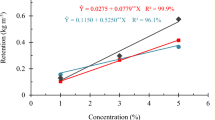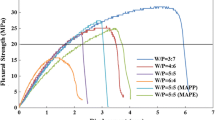Abstract
The objective of this study was to develop new vinyl flooring formulations with increased resistance to fungi and microorganisms attack, by using plasticizers having a chemical composition different from that of common di-ethylhexyl phthalate (DOP). It is suspected that during the vinyl flooring life service, the attack of fungi and microorganisms leads to the degradation of DOP and the release of some volatile organic compounds (VOC). For this reason the new materials were formulated with plasticizers having chemical composition different of that of DOP i.e.: diethyleneglycol dibenzoate (2–45), tricresyl phosphate (Lindol) and phenol alkylsulphonic ester (Mesamoll). For the same reason in the new flooring formulations the vinyl polymer, vinyl chloride-vinyl acetate copolymer (VC-VAc), was partially replaced with lignin (L) a natural polymer and major component of wood and vascular plants. Besides its other functions in wood, L imparts resistance to the most microorganisms attack. An organosolv lignin Alcell lignin (AL) was utilized as partial replacement of VC-VAc copolymer.
The influence of the new plasticizers, as well as the influence of the partial replacement of VC-VAc copolymer with L on the resistance of the new formulations to fungal attack was evaluated following a standard procedure given in ASTM G 21–2002 “Determining Resistance of Synthetic Polymeric Materials to Fungi”. The evaluation has been undertaken for controls (formulated without AL) and blends (formulated with 20 parts AL) specimens. Test specimens were inoculated with a mixture of five fungi. Following 28 days of incubation at 28°C and 95% relative humidity, the specimens were examinated visual and under the microscope and rated for fungal growth. Weight loss, changes in mechanical properties and changes in glass transition temperature due to the effect of biodeterioration were also determined.
Although each plasticizer has a specific resistance to hydrolysis due to differences among ester groups, the visible effects of fungal attack, in formulations without AL, is similar for all plasticized controls, with the exception of formulations incorporating diethyleneglycol dibenzoate (2–45) in which a higher degree of biodegradation was always present. Based on the weight loss of specimens formulated without AL, their resistance to fungal attack can be rated as follows: \(\hbox{Lindol} > \hbox{Mesamoll} \ge \hbox{DOP}> 2-45\). The same rating is applicable for blend specimens. The results have demonstrated that each particular AL-plasticizer-additives formulation has its specific mechanism of biodegradation.
Similar content being viewed by others
References
Wickson EJ (1993) Handbook of polyvinyl chloride formulations. John Wiley, New York
Godish T (1995) Sick building syndrome: definition, diagnosis and mitigation. Lewis Publisher, Boca Raton
Webb JS, Vander Mei HC, Nixon M, Eastwood IM, Greenhalagh IM, Read SJ, Robson D, Handley PS (1999) Appl Environ Microbiol 65:3575
Gumargalieva KZ, Zaikov GE, Semenov SA, Zhdanova OA (1999) Polym Degrad Stab 63:11
Wilson AS (1995) Plasticizers: principle and practice. Institute of Materials, London
Gandini A (1992) In: Allen G, Agrawal SL, Ruse SL (eds) Comprehensive polymer science, Suppl 1. Pergamon Press, London, p 543
Sterjiades R, Eriksson EL (1993) In: Scalbert A (ed) Polyphenolic phenomena. INRA Editions, Paris, p 115
Mlinar Y, Sarkanen SJ (1997) J Polym Sci, Polym Phys Ed 35:1899
Yoshida H, Morck R, Kringstadt KP (1987) Holzforschung 41:171
Feldman D, Banu D, Campanelli J, Zhu H (2001) J Appl Polym Sci 81:861
Darby JR (1982) In: Sears JR, Darby JR (eds) The technology of plasticizers. Willey, New York, p 79
Lin SY (1990) Ullman’s encyclopedia of industrial chemistry, vol A15. Wiley, New York, p 305
Buszard DL (1984) Titow WV (ed) PVC technology, 4th edn. Elsevier, New York, p 160
Feldman D, Banu D, Manley RStJ, Zhu H (2003) J Appl Polym Sci 89:2000
Darby JR, Sears JK (1976) In Nass LI (ed) Encyclopedia of PVC, vol. II. Marcel Decker, New York, p 249
Melan I (1961) The behaviour of plasticizers. Pergamon Press, New York
Semenov SA, Gumargalieva KZ, Zaikov GE (2003) Biodegradation and durability of materials under effect of microorganisms. VSP, Boston
Hitz HR, Mertz A, Zinkernagel R (1967) Mater Organismen 2:271
Hazeu W (1967) Intl Biodetn Bull 3:15 cf. Chemical Abstract
Bretislav D, Akimov GV (1967) Br Plast 40:109
Bochareva GG, Ovchinnikov YuV, Kurganova LN, Beirekhova LN (1975) Plastcheskie Massy 9:60 cf. Chemical Abstract
Li Y, Mlynar J, Sarkanen S (1995) International symposium on wood and pulping chemistry, 8th. Helsinki, June 6–9, vol 1, p 705
Tsukruk VV (2000) Polym Intl 49:441
Klausmeier RE (1972) Intl Biodetn Bull 8:3
Gilbert M (1994) JMS – Rev Macromol Chem Phys C 37:77
Illers KH (1977) J Macromol Sci – Phys B14:483
Hamlyn PF (1990) Textile 19:46
Wang H, Electorowicz M, Chifrina R, Banu D, Feldman D (2003) Annual conference of the Canadian Society of Civil Engineering. Moncton, New Brunswick, June 4–7, ENM 548-1-548-10
Gellerstedt G (1993) In Scalbert AS (ed) Polyphenolic phenomena. INRA, Paris, p 199
Gierer J, Lin Y (1972) Sven Paperstidn 75:233
Gellerstedt G, Pettersson EL (1977) Sven Paperstidn 80:15
Acknowledgments
The authors wish to thank the EJLB foundation and NSERC for their financial support.
Author information
Authors and Affiliations
Corresponding author
Rights and permissions
About this article
Cite this article
El-Aghoury, A., Vasudeva, R.K., Banu, D. et al. Contribution to the Study of Fungal Attack on Some Plasticized Vinyl Formulations. J Polym Environ 14, 135–147 (2006). https://doi.org/10.1007/s10924-006-0004-9
Published:
Issue Date:
DOI: https://doi.org/10.1007/s10924-006-0004-9




